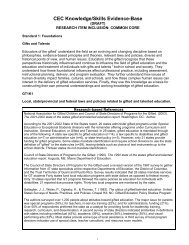2010 Pre-K-Grade 12 Gifted Programming Standards ... - NAGC
2010 Pre-K-Grade 12 Gifted Programming Standards ... - NAGC
2010 Pre-K-Grade 12 Gifted Programming Standards ... - NAGC
Create successful ePaper yourself
Turn your PDF publications into a flip-book with our unique Google optimized e-Paper software.
models for developing programs for the gifted and talented (2 nd ed., pp. 323-352). MansfieldCenter, CT: Creative Learning <strong>Pre</strong>ss.Renzulli, J. (1992) A general theory for the development of creative productivity through the pursuit ofideal acts of learning. <strong>Gifted</strong> Child Quarterly, 36, 170-183.Renzulli, J. (1994). Schools for talent development. Mansfield Center, CT: Creative Learning <strong>Pre</strong>ss.Renzulli, J. S., & Reis, S. M. (2003). The schoolwide enrichment model: Developing creative andproductive giftedness. In N. Colangelo & G.A. Davis (Eds.), Handbook of gifted education (3 rd ed.,pp.184-203). Boston, MA: Allyn & BaconRogers, K. B. (1991). The relationship of grouping practices to the education of the gifted and talentedlearner: Research-based decision making series. Storrs: University of Connecticut, NationalResearch Center on the <strong>Gifted</strong> and Talented.Rogers, K. B. (2002). Re-forming gifted education: Matching the program to the child. Scottsdale, AZ:Great Potential <strong>Pre</strong>ss.Scot, T. P., Callahan, C. M., & Urquhart, J. (2008). Paint-by-number teachers and cookie-cutter students:The unintended effects of high-stakes testing on the education of gifted students. Roeper Review,31, 40-52.Shaunessy, E., & Matthews, M. S. (2008). Accounting for gifted education: Making a case for reportingand transparency. Tampa: University of South Florida, David C. Anchin Center.Siegle, D. (2004). Using media and technology with gifted learners. Waco, TX: Prufrock <strong>Pre</strong>ss.Siegle, D., & McCoach, D. G. (2005). Extending learning through mentorships. In F. Karnes & S. Bean(Eds.), Methods and materials for teaching gifted (2 nd ed., pp. 473-518). Waco, TX: Prufrock<strong>Pre</strong>ss.Simonton, D. K. (1999). Talent and its development: An emergenic and epigenetic model. PsychologicalReview, 106, 435-457Southern, T. & Jones, E. (Eds.). (1991). The academic acceleration of gifted children. New York, NY:Teachers College <strong>Pre</strong>ss.Subotnik, R. F., & Olszewski-Kubilius, P. (1997). Restructuring special programs to reflect the distinctionsbetween children’s and adults’ experiences with giftedness. Peabody Journal of Education,72(3&4), 101-116.Swiatek, M. A. (1993). A decade of longitudinal research on academic acceleration through the study ofmathematically precocious youth. Roeper Review, 15, <strong>12</strong>0-<strong>12</strong>3.Tomlinson, C. A., Coleman, M. R., Allan, S., Udall, A., & Landrum, M. (1996). Interface between giftededucation and general education: Toward communication, cooperation, and collaboration. <strong>Gifted</strong>Child Quarterly, 40, 165-171.VanTassel-Baska, J. (2004). The acceleration of gifted students’ programs and curriculum. Waco, TX:Prufrock <strong>Pre</strong>ss.VanTassel-Baska, J., & Brown, E. F. (2007). An analysis of the efficacy of curriculum models in giftededucation. <strong>Gifted</strong> Child Quarterly, 51, 342-358.VanTassel-Baska, J., Olszewski-Kubilius, P., & Kulieke, M. (1994). A study of self-concept and socialsupport in advantaged and disadvantaged seventh and eighth grade gifted students. RoeperReview, 16, 186-191.Wessel, L. E. (1999). Career counseling for gifted students: Literature review and critique. ERICDocument Reproduction Services No. ED427267.Zeidner, M., & Schleyer, E. J. (1999). Evaluating the effects of full-time vs. part-time educationalprograms for the gifted: Affective outcomes and policy considerations. Evaluation and ProgramPlanning, 22, 413-427.Standard 6: Professional DevelopmentAncess, J. (2001). Teacher learning at the intersection of school learning and student outcomes. In A.Lieberman & L. Miller (Eds.), Teachers caught in the action: Professional development thatmatters (pp. 61-78). New York, NY: Teachers College <strong>Pre</strong>ss.Bain, S., Bourgeois, S., & Pappas, D. (2003). Linking theoretical models to actual practices: A survey ofteachers in gifted education. Roeper Review, 25, 166-172.National Association for <strong>Gifted</strong> Children • 1331 H St., NW, Suite 1001 • Washington, DC 20005 • 202.785.4268 • www.nagc.org15
















